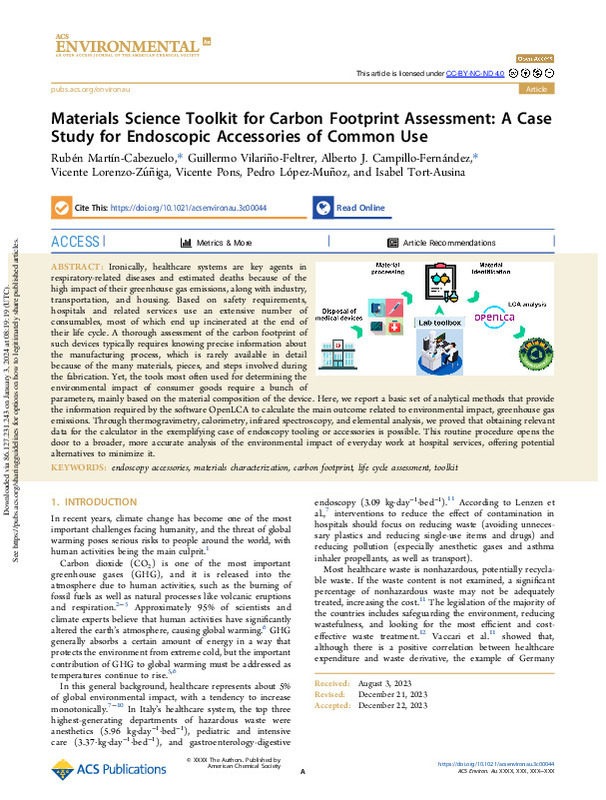JavaScript is disabled for your browser. Some features of this site may not work without it.
Buscar en RiuNet
Listar
Mi cuenta
Estadísticas
Ayuda RiuNet
Admin. UPV
Materials Science Toolkit for Carbon Footprint Assessment: A Case Study for Endoscopic Accessories of Common Use
Mostrar el registro sencillo del ítem
Ficheros en el ítem
| dc.contributor.author | Martín-Cabezuelo, Rubén
|
es_ES |
| dc.contributor.author | Vilariño-Feltrer, Guillermo
|
es_ES |
| dc.contributor.author | CAMPILLO FERNANDEZ, ALBERTO JOSE
|
es_ES |
| dc.contributor.author | Lorenzo-Zúñiga, Vicente
|
es_ES |
| dc.contributor.author | Pons, Vicente
|
es_ES |
| dc.contributor.author | López-Muñoz, Pedro
|
es_ES |
| dc.contributor.author | Tort-Ausina, Isabel
|
es_ES |
| dc.date.accessioned | 2024-01-03T19:04:02Z | |
| dc.date.available | 2024-01-03T19:04:02Z | |
| dc.date.issued | 2023-12-29 | es_ES |
| dc.identifier.uri | http://hdl.handle.net/10251/201422 | |
| dc.description.abstract | [EN] Ironically, healthcare systems are key agents in respiratory-related diseases and estimated deaths because of the high impact of their greenhouse gas emissions, along with industry, transportation, and housing. Based on safety requirements, hospitals and related services use an extensive number of consumables, most of which end up incinerated at the end of their life cycle. A thorough assessment of the carbon footprint of such devices typically requires knowing precise information about the manufacturing process, rarely available in detail because of the many materials, pieces and steps involved during the fabrication. And yet, tools most often used for determining the environmental impact of consumer goods just require a bunch of parameters, mainly based on the material composition of the device. Here we report a basic set of analytical methods that provide the information required by the software OpenLCA to calculate the main outcome related to environmental impact, the greenhouse gas emissions. Through thermogravimetry, calorimetry, infrared spectroscopy and elemental analysis we proved that obtaining relevant data for the calculator in the exemplifying case of endoscopy tooling or accessories is possible. This routine procedure opens the door to a broader, more accurate analysis of the environmental impact of everyday work at hospital services, offering potential alternatives to minimize it. | es_ES |
| dc.description.sponsorship | This study has been funded by Instituto de Salud Carlos III (ISCIII) through the project PI21/00193 and cofunded by the European Union. Funding: Instituto de Salud Carlos III (ISCIII), PI21/00193, cofunded by the European Union. And through the project PI2023-6 from UPV-LaFe innovation projects. | es_ES |
| dc.language | Inglés | es_ES |
| dc.publisher | American Chemical Society | es_ES |
| dc.relation.ispartof | ACS Environmental Au | es_ES |
| dc.rights | Reconocimiento - No comercial - Sin obra derivada (by-nc-nd) | es_ES |
| dc.subject | Endoscopy accessories | es_ES |
| dc.subject | Materials characterization | es_ES |
| dc.subject | Carbonfootprint | es_ES |
| dc.subject | Life cycle assessment | es_ES |
| dc.subject | Toolkit | es_ES |
| dc.subject.classification | MAQUINAS Y MOTORES TERMICOS | es_ES |
| dc.subject.classification | FISICA APLICADA | es_ES |
| dc.title | Materials Science Toolkit for Carbon Footprint Assessment: A Case Study for Endoscopic Accessories of Common Use | es_ES |
| dc.type | Artículo | es_ES |
| dc.identifier.doi | 10.1021/acsenvironau.3c00044 | es_ES |
| dc.relation.projectID | info:eu-repo/grantAgreement/ISCIII/Plan Estatal de Investigación Científica y Técnica y de Innovación 2017-2020 (ISCIII)/PI21%2F00193/ES/DESARROLLO DE ENDOFIS, UN NUEVO PRODUCTO SANITARIO PARA EL TRATAMIENTO ENDOSCOPICO DE LAS FISTULAS POSQUIRURGICAS DEL TRACTO DIGESTIVO/ | es_ES |
| dc.relation.projectID | info:eu-repo/grantAgreement/Hospital Universitari i Politècnic La Fe//PI2023-6/ | es_ES |
| dc.rights.accessRights | Abierto | es_ES |
| dc.contributor.affiliation | Universitat Politècnica de València. Escuela Técnica Superior de Gestión en la Edificación - Escola Tècnica Superior de Gestió en l'Edificació | es_ES |
| dc.contributor.affiliation | Universitat Politècnica de València. Escuela Técnica Superior de Ingenieros Industriales - Escola Tècnica Superior d'Enginyers Industrials | es_ES |
| dc.description.bibliographicCitation | Martín-Cabezuelo, R.; Vilariño-Feltrer, G.; Campillo Fernandez, AJ.; Lorenzo-Zúñiga, V.; Pons, V.; López-Muñoz, P.; Tort-Ausina, I. (2023). Materials Science Toolkit for Carbon Footprint Assessment: A Case Study for Endoscopic Accessories of Common Use. ACS Environmental Au. https://doi.org/10.1021/acsenvironau.3c00044 | es_ES |
| dc.description.accrualMethod | S | es_ES |
| dc.relation.publisherversion | https://doi.org/10.1021/acsenvironau.3c00044 | es_ES |
| dc.type.version | info:eu-repo/semantics/publishedVersion | es_ES |
| dc.identifier.eissn | 2694-2518 | es_ES |
| dc.relation.pasarela | S\506439 | es_ES |
| dc.contributor.funder | Instituto de Salud Carlos III | es_ES |
| dc.contributor.funder | Universitat Politècnica de València | es_ES |
| dc.contributor.funder | Hospital Universitari i Politècnic La Fe | es_ES |
| dc.subject.ods | 12.- Garantizar las pautas de consumo y de producción sostenibles | es_ES |
| dc.subject.ods | 13.- Tomar medidas urgentes para combatir el cambio climático y sus efectos | es_ES |
| dc.subject.ods | 15.- Proteger, restaurar y promover la utilización sostenible de los ecosistemas terrestres, gestionar de manera sostenible los bosques, combatir la desertificación y detener y revertir la degradación de la tierra, y frenar la pérdida de diversidad biológica | es_ES |








